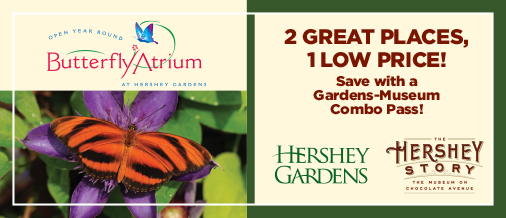by Lauren Ciriac Wenger
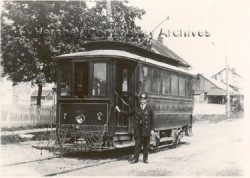
When Milton Hershey planned to build a chocolate factory and develop a community around it, he returned to the area in which he grew up. It was surrounded by farmland, including several dairy farms that would provide fresh milk for chocolate. Throughout the countryside, small towns were connected by dirt roads. Mr. Hershey saw the need for a convenient means of transportation for his community. He would need a way to easily haul milk to the factory, and enable workers to commute from neighboring towns.
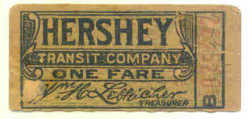
In 1903, even before the construction of the Hershey chocolate factory was complete, Milton Hershey had sponsored the creation of the Hummelstown & Campbelltown Street Railway Company, a trolley system that would connect Derry Church (Hershey) and the neighboring towns of Campbelltown, 4 miles to the east, and Hummelstown, four miles to the southwest. By the time the factory was built in June 1905, trolley service was established between Derry Church, Hummelstown, and Palmyra. It connected with the Lebanon & Annville Street Railway in Palmyra, and provided a route to Harrisburg via the Harrisburg & Hummelstown Street Railway through Paxtang. The fare per trip was quite affordable at 5 cents.

As the chocolate factory grew, so did the town and the trolley system. With demand for milk increasing, as well as the need for more workers, Milton Hershey focused on expanding the trolley system to reach more farms and towns. In the late 1910s and early 1920s, the trolley brought around 50,000 gallons of milk to the factory each day. Additional trolley cars were purchased to meet demands. Over time, the system extended to Lebanon and Elizabethtown. By connecting to other trolley systems, people could travel all the way to the cities of Reading, Lancaster, and Harrisburg. On December 13, 1913, the Hershey Transit Company was established through the consolidation of the Deodate & Hershey Street Railway, Elizabethtown & Deodate Street Railway, and Lebanon & Campbelltown Street Railway.
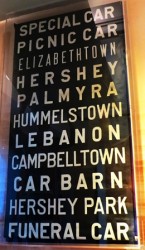
Not only did the trolley bring milk and employees to Hershey, but it also allowed Hershey residents to easily visit friends and family and to shop in neighboring areas. Likewise, residents of neighboring towns could visit Hershey for leisure purposes. Hershey Park, situated along Spring Creek, was a sought-after destination for picnicking, relaxing, and visiting with friends. In its early years it had a pavilion for dancing and skating, a bandstand for concerts, playgrounds, a boating lake, a baseball field, and tennis courts. A merry-go-round, the park’s first ride, was added in 1908, with more rides such as roller coasters added in the following years. The trolley was the main source of transportation to the park, with weekend picnickers coming in droves on so-called “picnic trolleys”—trolley cars specially chartered from neighboring trolley lines in Harrisburg, Lebanon and Lancaster.

Cyril J. Little, a Lebanon, PA resident born in 1920, remembered taking the trolley to Hershey Park:
“…Hershey was about nine miles away and it was a great place to go, especially the park. Kids are enamored of amusement parks, especially things like the roller coaster… Riding on the trolley car was an experience itself.” (Oral History interview, 9/15/90. 90OH25. Hershey Community Archives Oral History Collection, Hershey, PA).
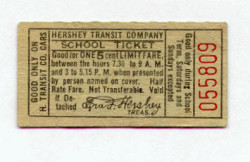
The trolley also served as a reliable means of transport for schoolchildren, including Hershey Industrial School students. Thomas Pratt, retired employee of Hershey Industrial School, remembered:
“… [T]he boys were transported to the school largely by trolley. The trolleys would come up the hill, and there would be at least a half a dozen or maybe seven or eight trolleys come up… The trolleys would come back up the hill and would pick up the boys and take them back to their units, their farm home. … [W]e always would hope for snow days, because they hoped the trolleys wouldn’t get there. But the trolleys always got through in the snow.” (Oral History interview, 1982. 89OH44. Hershey Community Archives Oral History Collection, Hershey, PA).
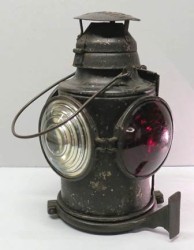
In the 1920s, the automobile gained in popularity. Though some employees were now driving to work, many still used the trolley. It was also still utilized for hauling milk, and for express service transporting freight for area businesses. However, this was the first sign of things to come. In the 1930s, passenger use declined, and trucks began to take over most of the milk hauling. Trolleys connecting to the Hershey line in Palmyra were discontinued.

In the following years, the Ephrata and Lebanon system made its last trips and the tracks to Elizabethtown were torn up. The entire trolley system would likely have ended in 1942 had it not been for WWII’s rationing of gas and oil. Public transportation once again increased, and for four more years Hershey Transit’s trolley ran between Hummelstown, Hershey, Palmyra, Campbelltown, and The Hotel Hershey.

Finally, after the war ended, inevitably so did the Hershey trolley system. On December 21, 1946, trolley cars No. 17, No. 21, and No. 23 made their last runs to Campbelltown, Palmyra, and Hummelstown. The next day the system was replaced by buses and personal automobiles. Though many residents were sad to see it go, the trolleys had a good run. The Hershey Transit Company trolleys had served the town well for over 40 years, transporting the community, factory employees, tourists, fresh milk for chocolate, and freight for area businesses across 35 miles of track, using 34 trolley cars. It undoubtedly played an essential role in the success of the Hershey Chocolate Company and the town of Hershey, Pennsylvania.


